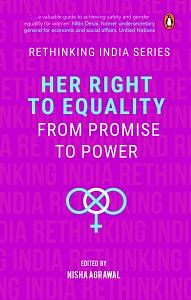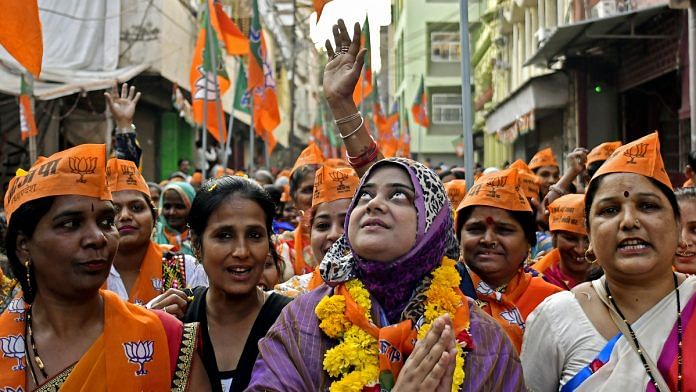Studying women’s electoral campaigns unveils a character distinct from men’s campaigns, although the latter has come to be seen as normative. Discounting celebrity candidates, that is, tall party leaders, ground campaigns are formulaic: teams composed of local male leaders decide the campaign calendar and lead the local outreach initiatives. Events include mid-sized roadshows to mobilize cadres and volunteers, and announce candidate momentum; large rallies in open grounds establish strength and winnability. Motorbike rallies fronted by exuberant young men showing off campaign vitality and velocity, small neighbourhood meetings with locally connected volunteers signalling accessibility and likability, and, of course, door-to-door outreach to get votes are other stock features. Male politicians’ roadshows and rallies are almost entirely male-dominated, barring a smattering of women designated to be front and centre cameos to check the box. Women voters are not impressed by motorbike cavalcades while rallies and roadshows at night are even less attractive. As a rule, the larger the ground covered by a rally or roadshow, and the more teeming the crowd, fewer the voluntary female attendees. Stage set-ups are also bereft of women, and if there are a token one or two, they are present only for brightening up the pictures. They are not allotted any microphone time. Like a female party leader said, ‘They always take the trouble of herding a few of us to the rally, and seat us on stage with the promise of a moment in the spotlight.
Also read: Women voters in Indian democracy: A silent revolution
We are carefully arranged in the last row of chairs, always a bad omen of things to come, or rather not to come. After hours on our backsides as showpieces, and hours staring at the backsides of various male leaders, the rally closes with not a single word uttered by any of us women “leaders”!’ With women candidates, neighbourhood meetings tend to be more even-keeled, and many have a preponderance of women. Door-to-door campaigns always have a notable female cadre presence, as that is a major factor for families to open homes to campaign teams. All-male door-to-door campaigners are viewed with some suspicion and are mostly unwelcome inside homes. In men’s campaigns, women are rarely part of the inner circle of campaign strategy, with little influence on where the campaign goes, what it does, who it meets and when, and even campaign messaging, communications and social media. Women’s campaign teams also tend to engage more women in decision-making capacities. Male volunteers likely still devise campaign strategies, but with female influence. Women’s campaigns do more roadshows, neighbourhood meetings and lesser large-scale rallies and motorbike cavalcades. Their roadshows are lined with more women, many of whom spontaneously approach the campaign vehicle; a scene rarely witnessed with the average male candidate. Public meetings see women as comprising half the audience. Neighbourhood meetings are chock-full of women, and rendezvous with women’s groups dominate the calendar. ‘Get out the vote’ is a female riot! Campaigning to women, one candidate specifically says, ‘I am a woman leader; I will encourage you. There are 1.25 lakh posts from village panchayat to mayor, of which 60,000 are women’s posts. I want you to equip yourselves for leadership and bring along more women as well.’
Also read: Political parties think women are ‘weak’ candidates, but data doesn’t say so
Men’s campaigns rarely have gender-targeted messaging, which, of course, rings truer when the candidate is a woman.
Women spontaneously come out to greet the candidate, and there is visible participation of women as volunteers, as part of the audience and the engaged electorate when the candidate is female. Women also run booths, a function otherwise exclusively carried out by males. Another candidate mentions, ‘When we meet women voters or volunteers, we openly ask to freshen up at their homes at campaign stops. It is much easier than asking men, and develops a bond with the family.’ The real kicker is this! When women are candidates, and they win, there is a basic democratic principle that is fulfilled: the female half of the electorate’s problems is heard.
Also read: Indian women a step closer to breaking glass ceiling in politics
Women seldom approach male representatives in rural and even in urban areas. They find female MLAs and MPs much more accessible, and thus bring focus to issues that matter to half the electorate, issues that have hitherto never been heard or have been dismissed. Even when women candidates do not win, women voters, volunteers and female party cadres are much more engaged, participating in and leading campaigns. Women’s active engagement in election campaigns is a quintessential feature of democracy, one that has rarely manifested in Indian politics. It is almost never seen in campaigns of male candidates, where rooms full of men are typical. This is the stark outcome of a surfeit of men in politics; a hindrance to both fair elections and equitable governance. This hands-on engagement in electoral politics can be forged best through women candidates. It can transform India through a virtuous cycle of more women becoming politically active, grassroots leaders running larger scale campaigns and hence earning more leverage for candidacy themselves.
 This excerpt from Her Right to Equality: From Promise to Power has been published with special permission from Penguin Random House India.
This excerpt from Her Right to Equality: From Promise to Power has been published with special permission from Penguin Random House India.






